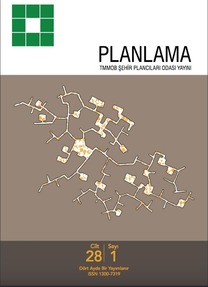Komşuluk Birimi Ölçeğinde, Coğrafi Bilgi Sistemleri Tabanlı Bir Kentsel Sürdürülebilirlik Değerlendirme Modeli Önerisi
A Geographical Information System Based Urban Sustainability Evaluation Model Proposal In Neighbourhood Scale
___
- Australia Green Building Council. (2016). Green Star Communities-Rating Tool: Australia Green Building Council.
- Beatley, T. (2012). Green cities of Europe: global lessons on green urbanism. Washington DC: Island Press.
- BRE Global Ltd. (2012). BREEAM Communities Technical Manual. Fedeski, M., & Gwilliam, J. (2007). Urban sustainability in the presence of flood and geological hazards: The development of a GIS-based vulnerability and risk assessment methodology. Landscape and urban planning, 83(1), 50-61. doi:10.1016/j.landurbplan.2007.05.012
- Ford, A. C., Barr, S. L., Dawson, R. J., & James, P. (2015). Transport Accessibility Analysis Using GIS: Assessing Sustainable Transport in London. Isprs International Journal of Geo-Information, 4(1), 124-149. doi:10.3390/ijgi4010124
- Gál, T., Lindberg, F., & Unger, J. (2009). Computing continuous sky view factors using 3D urban raster and vector databases: comparison and application to urban climate. Theoretical and Applied Climatology, 95(1), 111-123. doi:10.1007/s00704-007-0362-9
- Japan Sustainable Building Consortium. (2014). CASBEE for home and urban development technical manual.
- Mastercard Worldwide ve Boğaziçi Üniversitesi. (2011). Türkiye’nin Şehirleri Sürdürülebilirlik Araştırması. Retrieved from http://v3.arkitera.com/ UserFiles/File/download/ Turkiyenin_Illeri_Surdurulebilirlik_Arastirmasi.pdf
- Nguyen, B. K., & Altan, H. (2011). Comparative review of five sustainable rating systems. 2011 International Conference on Green Buildings and Sustainable Cities, 21, 376-386. doi:10.1016/j.proeng.2011.11.2029
- Özügül, M. D., Çekiç, T. İ., & Özbakır, A. (2014). The next wave of sustainable planning: green neighbourhood assessment systems. International Journal of Environment and Sustainable Development, 13(2), 109-125. doi:10.1504/IJESD.2014.060188
- Ratti, C., & Richens, P. (2004). Raster analysis of urban form. Environment and Planning B-Planning & Design, 31(2), 297-309. doi:10.1068/b2665
- Reith, A., & Orova, M. (2015). Do green neighbourhood ratings cover sustainability? Ecological Indicators, 48, 660-672. doi:10.1016/j. ecolind.2014.09.005
- Rode, P., Keim, C., Robazza, G., Viejo, P., & Schofield, J. (2014). Cities and Energy: Urban Morphology and Residential Heat-Energy Demand. Environment and Planning B: planning and design, 41(1), 138-162. doi:10.1068/b39065
- Sharifi, A., & Murayama, A. (2013). A critical review of seven selected neighborhood sustainability assessment tools. Environmental Impact Assessment Review, 38, 73-87. doi:10.1016/j.eiar.2012.06.006
- Sharifi, A., & Murayama, A. (2014). Neighborhood sustainability assessment in action: Cross-evaluation of three assessment systems and their cases from the US, the UK, and Japan. Building and Environment, 72, 243- 258. doi:10.1016/j.buildenv.2013.11.006
- UN Habitat. (2016). Urbanization and Development Emerging Futures. World Cities Report.
- US Green Building Council. (2016). LEED for neighborhood development v4.
- ISSN: 1300-7319
- Yayın Aralığı: 3
- Başlangıç: 1986
- Yayıncı: TMMOB Şehir Plancıları Odası
Meriç Demir KAHRAMAN, HANDAN TÜRKOĞLU
Gökçer OKUMUŞ, HANDAN TÜRKOĞLU
STK’ların Yerel Kapasite Geliştirmede ve Yerel Kalkınmada Rolü; Antakya Örneği
Kezban BECERİKLİ, Bilge Armatlı KÖROĞLU
Yaratıcı Ekonominin Kentsel Alandaki Varlığı: Plancının Rolü ve Farkındalık Üzerine
İzmir’de Kentsel Dönüşüm Projelerinde Sürdürülebilir İnşaat Atık Yönetiminin Değerlendirilmesi
Ankara İli Beypazarı İlçesi Kırsal Turizm Gelişimi ve Yerel Kalkınmaya Etkisi
Ferdağ TATAR, Bilge Armatlı KÖROĞLU
Kent Kimliğinde İbadet Yapıları: Antakya Örneği
